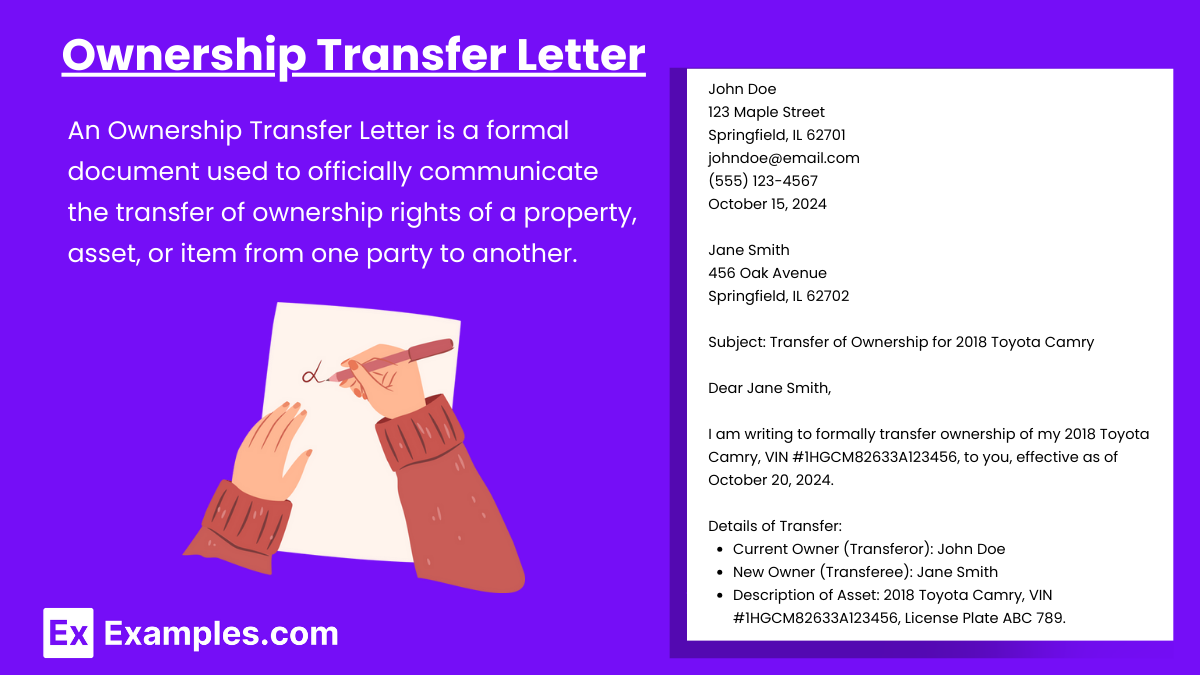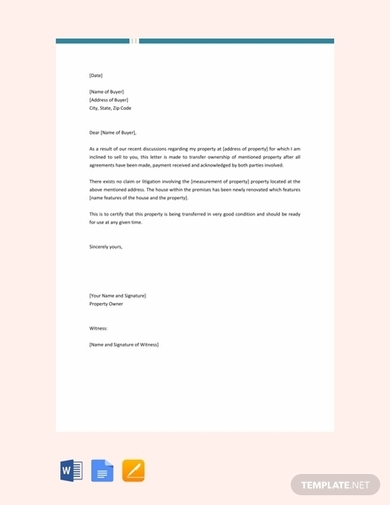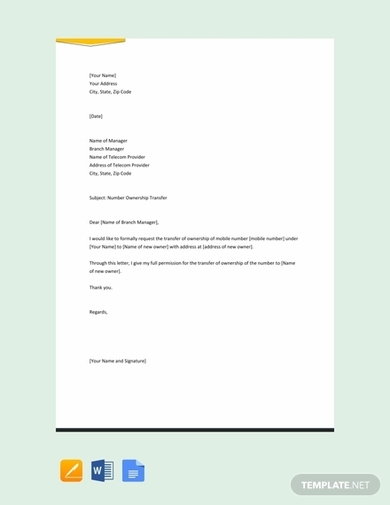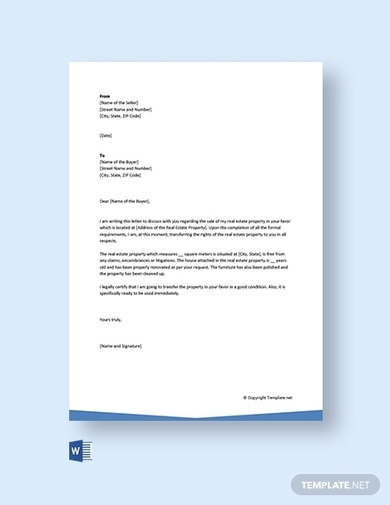15+ Ownership Transfer Letter Examples to Download
An Ownership Transfer Letter is a formal document used to officially communicate the transfer of ownership rights of a property, asset, or item from one party to another. This letter provides essential details about the transfer, including information about both the current and new owners, a description of the asset or property being transferred, and the effective date of the transfer. The purpose of this letter is to create a clear and legally recognized record of the ownership change, which helps protect the rights of both parties involved and ensures transparency in the transaction. Ownership Transfer Letters are commonly used in the transfer of real estate, vehicles, businesses, and other valuable assets.
What is an Ownership Transfer Letter?

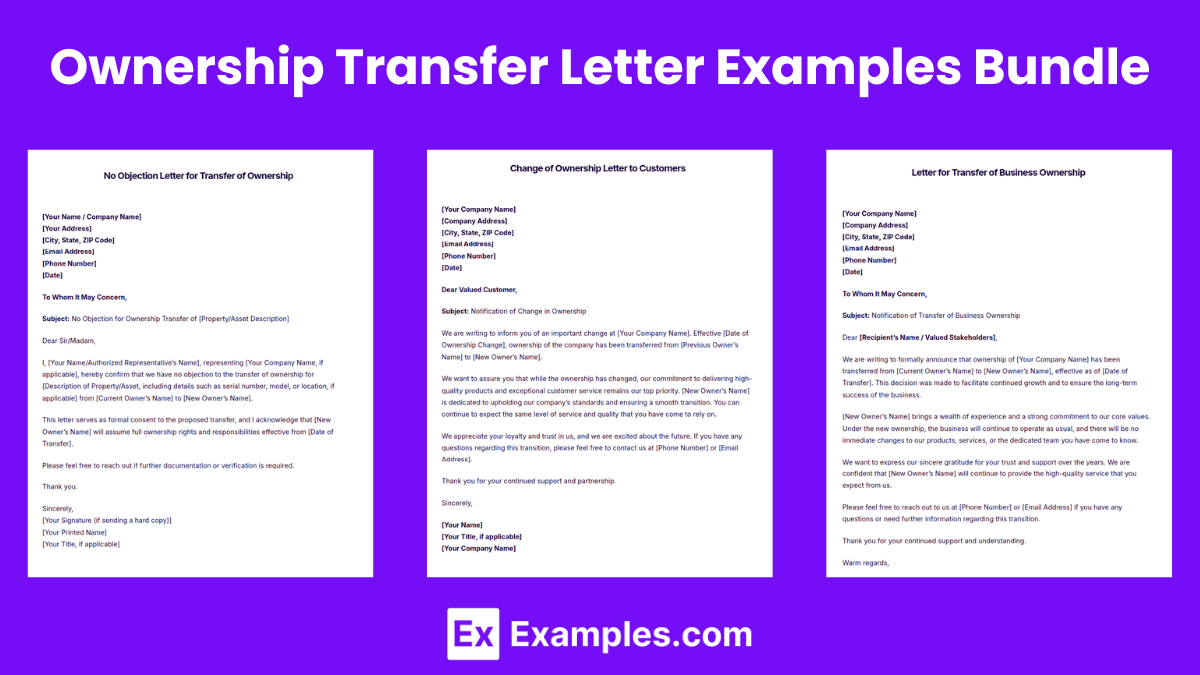
Download Ownership Transfer Letter Examples Bundle
Ownership Transfer Letter Format
Header Information
- Sender’s Full Name
- Sender’s Address
- Sender’s Email Address
- Sender’s Phone Number
- Date of the Letter
Recipient Information
- Recipient’s Full Name
- Recipient’s Address
Subject Line
Clearly state the purpose, e.g., “Ownership Transfer Letter for [Property/Asset Name]”
Salutation
Address the recipient formally, e.g., “Dear [Recipient’s Name],”
Body of the Letter
- Introduction: State your intent to transfer ownership of the property or asset.
- Details of the Transfer:
- Description of the Property/Asset (include specifics like model number, location, etc.)
- Names of both the Transferor (current owner) and Transferee (new owner)
- Reason for Transfer (e.g., sale, gift, inheritance)
- Date of Transfer
- Additional Terms or Conditions: (if applicable)
Closing Statement
- Acknowledge any additional actions required for the transfer
- Provide contact information for follow-up
Signature
Sign the letter with your name and title (if applicable)
Example of a Transfer of Ownership Letter
John Doe
123 Maple Street
Springfield, IL 62701
johndoe@email.com
(555) 123-4567
October 15, 2024
Jane Smith
456 Oak Avenue
Springfield, IL 62702
Subject: Transfer of Ownership for 2018 Toyota Camry
Dear Jane Smith,
I am writing to formally transfer ownership of my 2018 Toyota Camry, VIN #1HGCM82633A123456, to you, effective as of October 20, 2024.
Details of Transfer:
- Current Owner (Transferor): John Doe
- New Owner (Transferee): Jane Smith
- Description of Asset: 2018 Toyota Camry, VIN #1HGCM82633A123456, License Plate ABC 789
- Reason for Transfer: Private Sale
- Agreed Sale Price: $15,000
By signing below, both parties acknowledge the terms of this transfer and agree that ownership rights to the above vehicle are fully transferred to Jane Smith as of the effective date.
Please feel free to reach out to me if you need further details or any additional documentation for this transfer.
Thank you.
Sincerely,
John Doe
(Signature if sending a hard copy)
No Objection Letter for Transfer of Ownership
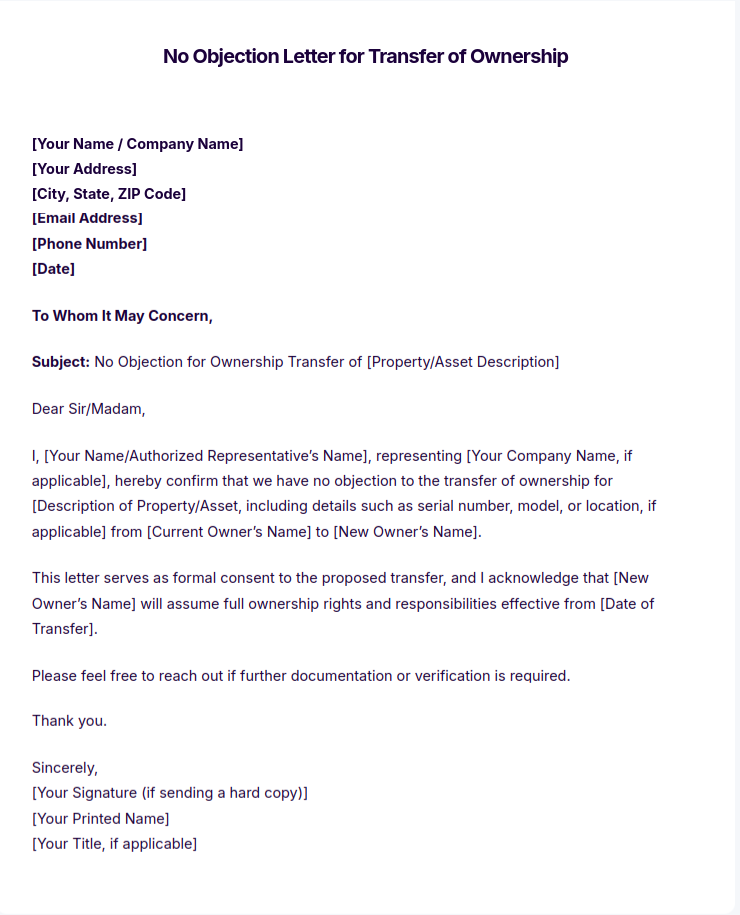
Change of Ownership Letter to Customers

Letter for Transfer of Business Ownership
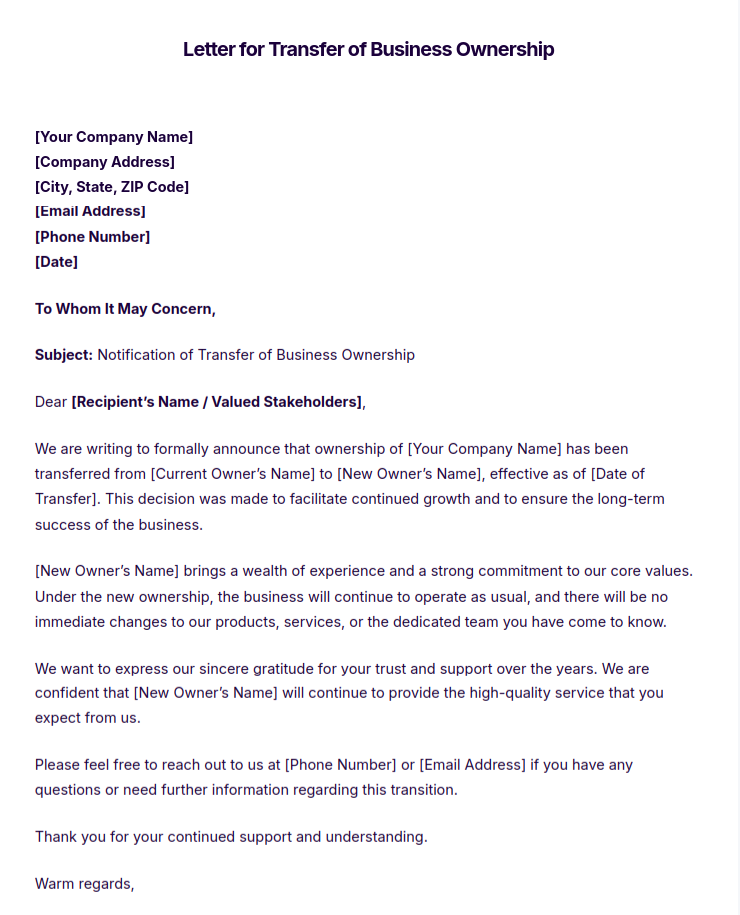
More Ownership Transfer Letter Examples and Samples
- Letter for Transfer of Vehicle Ownership
- Ownership Transfer Letter for Property
- Letter of Transfer of Ownership of Land
Ownership Transfer Letter Examples and Templates
Ownership Transfer Letter
Ownership Transfer Letter in Block Style
Letter of Transfer of Ownership of Property
Vehicle Ownership Transfer Letter
Letter of Transfer of Ownership from the Seller
Department of Transportation Transfer of Ownership Letter Sample
Purpose of Ownership Transfer Letter
- Establishes Legal Documentation
- The letter provides a formal record of the transfer, helping to avoid future disputes or misunderstandings.
- It clearly states the names of the parties involved, the asset in question, and the date of transfer.
- Clarifies Terms and Conditions
- The letter outlines any specific terms, conditions, or obligations associated with the transfer.
- This includes any warranties, payment terms, or other conditions the parties have agreed upon.
- Serves as Proof of Ownership Transfer
- The letter acts as evidence that ownership has legally shifted from one party to another, which can be useful for tax purposes, insurance claims, or legal matters.
- Facilitates Smooth Transition of Ownership
- By providing clear documentation, it helps ensure a smooth transition, allowing the new owner to take control of the asset without issues.
- This is especially important when dealing with government agencies or third parties who require proof of transfer, such as the DMV for vehicle transfers.
- Protects Both Parties Involved
- The letter can help protect the previous owner from liabilities or obligations related to the asset after the transfer date.
- For the new owner, it serves as confirmation of their rights to the asset, ensuring they are recognized as the legitimate owner.
How to Write an Ownership Transfer Letter ?
End with a Closing Statement and Signatures
Writing an Ownership Transfer Letter is a straightforward process, but it’s important to include all necessary information to ensure the transfer is legally binding and protects the interests of both parties. Below are the steps and components needed to create a comprehensive ownership transfer letter.
Use a Formal Letter Format
Header: Begin with your name and address at the top, followed by the date. Below that, include the recipient’s name and address.
Subject Line: Include a subject line that states the purpose, such as “Ownership Transfer of [Asset Name].”Start with a Greeting
Address the letter formally, using “Dear [Recipient’s Name]” or “To Whom It May Concern” if the recipient’s name is unknown.
State the Purpose of the Letter
In the opening paragraph, clearly state that you are transferring ownership of the specific asset. Include a brief description of the asset and the reason for the transfer, if relevant.
Describe the Asset Being Transferred
Provide detailed information about the asset to avoid confusion. Include specifics like:
For Property: Address, legal description, or parcel number.
For a Vehicle: Make, model, year, and VIN (Vehicle Identification Number).
For Business Shares: Number of shares, company name, and any other relevant details.Specify the Terms and Conditions of the Transfer
Outline any terms or conditions associated with the transfer, such as:
Financial Terms: Payment amount, if applicable.
Warranties or Guarantees: Any warranties provided by the current owner.
Liabilities and Obligations: Specify if any liabilities transfer to the new owner or remain with the current owner.Confirm the Transfer of Ownership
Include a statement that formally confirms the transfer of ownership to the new owner, specifying the effective date. Example: “As of [date], I hereby transfer all rights, ownership, and interest in [asset] to [new owner’s name].”
Include Contact Information for Both Parties
Provide your contact information and the recipient’s contact information, such as phone number and email, to facilitate any follow-up questions.
End with a Closing Statement and Signatures
Use a closing statement, such as “Sincerely” or “Yours faithfully.”
Leave space for signatures of both parties, as well as the date of signing. If needed, include a space for a witness signature.
FAQ’s
When is an Ownership Transfer Letter Needed?
An ownership transfer letter is typically needed when transferring ownership of significant assets, such as real estate, vehicles, business shares, or other valuable items. It is commonly used in sales, gifts, inheritance transfers, or when assets are transferred between family members or business partners.
What Information Should Be Included in an Ownership Transfer Letter?
An ownership transfer letter should include:
Names and contact information for both the current owner and the new owner.
A detailed description of the asset being transferred.
The terms and conditions of the transfer, including any payment, warranties, or obligations.
A formal statement of the transfer of ownership, including the effective date.
Signatures of both parties involved, along with the date of signing.
Is an Ownership Transfer Letter Legally Binding?
Yes, an ownership transfer letter can be legally binding if it includes the essential details, such as a clear statement of transfer, specific asset details, terms of the agreement, and signatures of both parties. However, it is often recommended to have the document notarized or witnessed, depending on the type of asset and legal requirements in the region.
Do I Need a Lawyer to Draft an Ownership Transfer Letter?
While you can draft an ownership transfer letter on your own, it may be beneficial to consult with a lawyer, especially for high-value assets or complex transfers. A lawyer can ensure that the letter is legally sound, complies with local regulations, and covers all necessary terms to protect both parties involved.
Can an Ownership Transfer Letter Be Used for Transferring Business Ownership?
Yes, an ownership transfer letter can be used to transfer ownership of business assets or shares. It should clearly specify details such as the percentage of shares, roles or responsibilities, and any specific terms of the transfer. For complex business transfers, it’s advisable to also include or reference additional legal documents, such as a sale agreement or partnership agreement.


